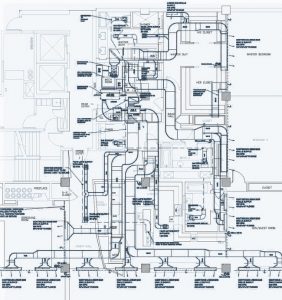The proper design and installation of HVAC systems for commercial buildings is critical for their efficient operation, ensuring the lowest possible energy costs.
Heating and air conditioning systems are not one-size-fits-all. Since commercial buildings vary in size, structure, and use, the design and configuration of the heating and air conditioning systems are customized to meet the needs of each individual structure. Poor heating system design, installation, and/or configurationcan cause intractable problems at the worst possible times, with the very real risk of impacting the operations, costs, and revenue for the company occupying the space, and perhaps the owner of the building.
What can property and facilities managers do to mitigate these risks? Know the basics.
Heating System Design
 The architectural details and layout of the interior offices and work areas determine the design and configuration approach taken before construction begins. There are several choices and variations of heating and air conditioning systems, from hydronic piping to constant volume forced hot air, to multi-zone VAV systems, to smaller split systems and VRF heat pumps.
The architectural details and layout of the interior offices and work areas determine the design and configuration approach taken before construction begins. There are several choices and variations of heating and air conditioning systems, from hydronic piping to constant volume forced hot air, to multi-zone VAV systems, to smaller split systems and VRF heat pumps.
Both the intended use for the building – whether offices, industrial, warehouse, multi-family, or healthcare – and the cost of heating and cooling it are the two factors that drive the decision of which type system will be used. Once the overall choice has been made, the actual variation and configuration depends on the unique needs of the building’s occupants. But what happens when the building is re-purposed or the occupants move? The resulting “fit-out” for the new occupants is fraught with risk.
Many times a mechanical re-design is commissioned, including the re-configuration of the heating and cooling systems. But just as often those systems are not re-configured and therefore cannot meet the needs of a new application and use. Hot and cold spots – not hilarity – usually ensue.
Installation, Configuration, and Ventilation of Heating Systems
Ductwork is the conduit through which warm or cool air is carried from the equipment that produces it to the areas to be conditioned. Techniques for installing and sealing that ductwork are different today than a generation ago. A contractor’s craftsmanship varies from company to company, just as the quality of any product would vary in relation to the cost. As a result, while the equipment may be working properly, the ductwork could be leaking, for example, and wasting energy and reducing comfort.
The placement of the air grilles – where the air exits the ductwork to heat a particular area – may also be the culprit. For example, if an area of a building was formerly comprised of separate offices and now has an open space plan design with a lot of heat-producing equipment, the volume of air or hot water – in the case of a hydronic system – may be incorrect. Another example may be the increased heat from the sun’s rays, or absence thereof, coming through the windows. The result? The volume of warm or cool air needs to be adjusted during specific hours.
Comfort is usually top of mind when considering a heating system. However, health is also an important element and is a huge priority when designing and configuring a heating system. Ventilation mitigates the risk of poor IAQ (Indoor Air Quality). The execution of that design includes the proper installation of ductwork and filtration systems.
HVAC Controls and Zoning
Heating and cooling systems can be “zoned” so that different sensors can control different areas of the building by telling the HVAC equipment when to supply more or less air – whether warm or cool – for any given space. For example, low occupancy areas can be kept relatively cooler during the winter and hotter during the summer in order to save energy. In addition, different areas in a building, even on the same floor, could require different levels of conditioned air due to the number of occupants and office equipment. Many are familiar with computer server rooms, which usually require cool air year round due to the amount of heat produced by the equipment. Similarly, a training room designed for 50 occupants will need a larger volume of conditioned air during its use as opposed to when it’s unoccupied.
Of course, when tenants move in and out, the application and use of different areas will evolve and the concomitant changes to the configuration of the HVAC system may not have been implemented or even contemplated. (For more information on configurable HVAC systems, see our white paper on VRF HVAC systems by clicking here.)
Other Causes of Hot and Cold Spots
In addition to the configuration of the heating and cooling system, problems may exist in the equipment itself – thermostats that are failing, equipment with incorrect capacity, defective equipment components, inefficient heat exchangers or coils, even building’s pressurization. So how does one troubleshoot and solve the issue of hot and cold spots?
Look for a mechanical contractor that is experienced in both the installation and service of heating and air conditioning systems.
Most HVAC contractors are familiar with only one (installation) or the other (service). Having experience in both these different disciplines ensures that the cause is quickly identified and a solution proposed and implemented, which reduces the cost of repair and maximizes the comfort of the building’s occupants.
Questions about hot and cold spots in your building? Request more information on the commercial heating and cooling services from Integrate Comfort Systems.







